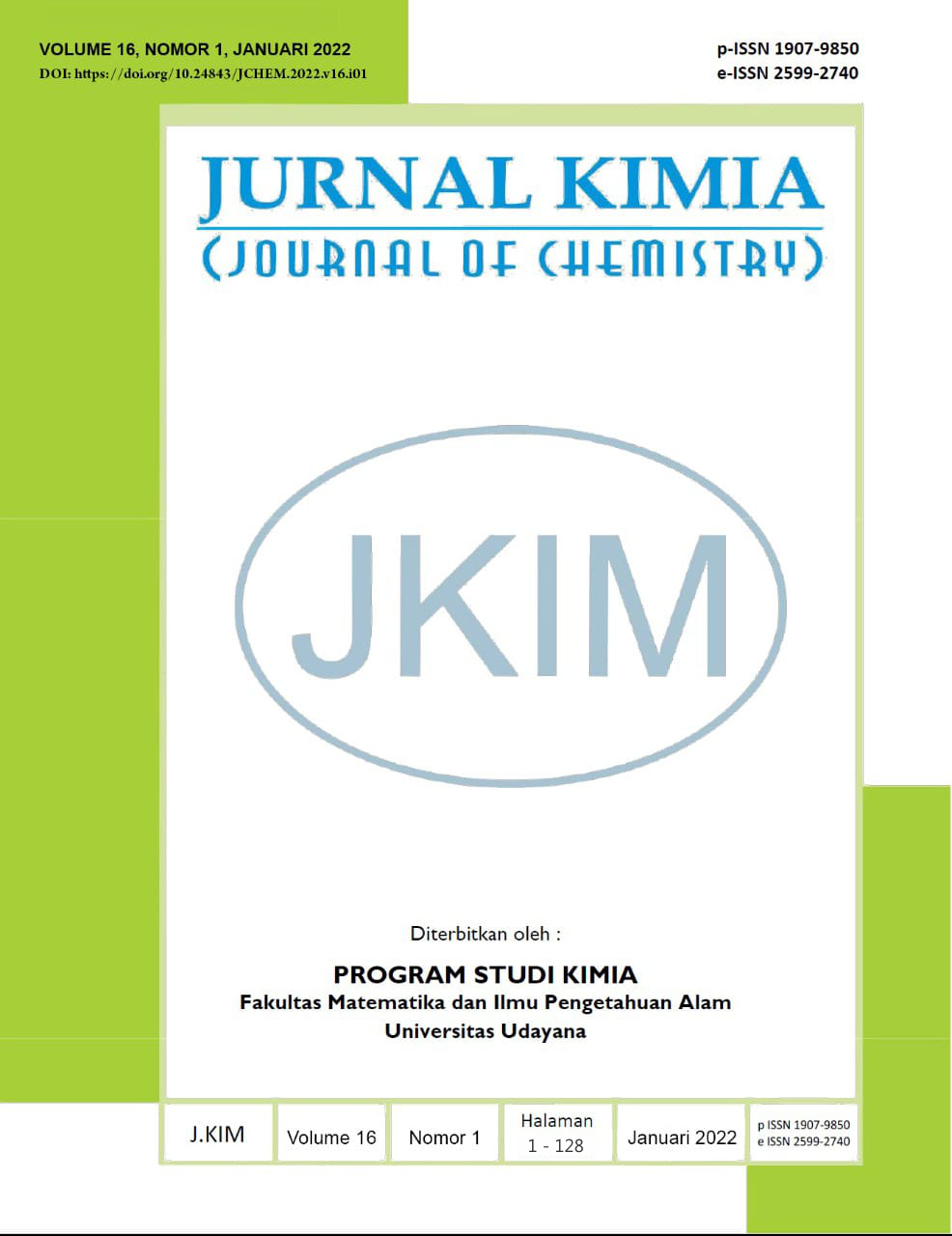POTENSI KULIT PISANG SEBAGAI INHIBITOR RESEPTOR ANDROGEN PADA ACNE VULGARIS MENGGUNAKAN METODE IN SILICO
Abstract
Acne vulgaris merupakan gangguan kulit yang umum terjadi pada manusia. Acne vulgaris merupakan penyakit yang terjadi akibat peradangan kronis dari kelenjar pilosebasea dengan prevalensi puncak terjadi pada usia remaja. Dalam patogenesis Acne vulgaris, androgen berperan penting terhadap timbulnya Acne vulgaris. Androgen merangsang sintesis lemak dan diferensiasi dari sebosit sehingga timbulah Acne vulgaris. Selama ini, kulit pisang telah dipercaya secara tradisional bagus untuk sel kulit sehingga dapat berpotensi sebagai terapi untuk Acne vulgaris. Tujuan dari penelitian ini yaitu untuk memprediksi potensi kulit pisang sebagai penghambat reseptor androgen pada Acne vulgaris dengan metode in silico. Penelitian ini dilakukan dengan tahapan persiapan struktur 3D ligand senyawa fenolik kulit pisang dan molekul protein reseptor androgen, optimasi struktur ligand, preparasi struktur protein, penentuan grid box, molecular docking, dan visualisasi hasil docking. Dari hasil docking senyawa fenolik kulit pisang: ferulic acid, sinapic acid, (+)-catechin, dan (-)-Epicatechin, didapatkan energi ikatan masing-masing yaitu sebesar -3,99, -3,67, -5,62, -5,14 kkal/mol sehingga berpotensi menghambat reseptor androgen pada patogeneis Acne vulgaris. Walaupun hasil docking senyawa fenolik kulit pisang lebih besar dari spironolactone dan flutamide yang memiliki energi ikatan sebesar -6,29 dan -5,94 kkal/mol, namun (+)-catechin dan (-)-Epicatechin mempunyai energi ikatan yang tidak jauh berbeda dan mempunyai konstanta inhibisi lebih kecil dari kedua obat Acne vulgaris tersebut.
Kata Kunci: Acne vulgaris, fenolik, in silico, kulit pisang, reseptor androgen.
Acne vulgaris is a common skin diseaseamong human. Acne vulgaris occurs due to chronic inflammation of the pilosebaceous glands with peak prevalence during adolescence. It is well-known, androgen plays important role in the development of Acne vulgaris. Androgen stimulates fat synthesis and differentiation from sebocytes, causing Acne vulgaris. So far, banana peels is empirically believed to have beneficial effect for skin cells, hence it potential as a therapy for Acne vulgaris is yet to be elucidated. The purpose of this study is to evaluate the potential of banana peels as an inhibitor of androgen receptors in Acne vulgaris with computer model. This research was conducted with the stages of preparing the 3D ligand structure of phenolic compounds of banana peel and androgen receptor protein molecules, optimization of ligand structures, preparation of protein structures, determination of grid boxes, molecular docking, and visualization of docking results. Based on docking result, banana peel phenolic compounds, ferulic acid, synapic acid, (+)-catechin, and (-)-Epicatechin, the respective bond energies were -3.99, -3.67, -5.62, -5.14 kcal/mol. Therefore, banana peels potentially inhibits androgen receptors. Although the docking results of banana peel phenolic compounds were greater than spironolactone and flutamide which had bond energies of -6.29 and -5.94 kcal/mol, (+)-catechins and (-)-Epicatechin showed similar bond energies with those drugs.
Keywords: Acne vulgaris, androgen receptors, banana peels, in silico Phenolate.
Downloads
References
Cong, T.-X., Hao, D., Wen, X., Li, X.-H., He, G., & Jiang, X. (2019). From pathogenesis of acne vulgaris to anti-acne agents. Archives of Dermatological Research, 0(0), 0. https://doi.org/10.1007/s00403-019-01908-x
Estebanez-Perpina, E., Arnold, L. A., Nguyen, P., Rodrigues, E. D., Mar, E., Bateman, R., … Fletterick, R. J. (2007). A surface on the androgen receptor that allosterically regulates coactivator binding, 104(47).
FAOSTAT. (2017). Banana facts and figures. Retrieved from http://www.fao.org/economic/est/est-commodities/bananas/bananafacts/en/#.Xfw9GNozbIU
Goldsmith, L. A., Katz, S. I., Gilchrest, B. A., Paller, A. S., Leffell, D. J., & Wolff, K. (2012). Fitzpatrick’s Dermatology in General Medicine (8th ed.). New York: Mc Graw Hill.
Hari, S. (2019). In silico molecular docking and ADME / T analysis of plant compounds against IL17A and IL18 targets in gouty arthritis. Journal of Applied Pharmaceutical Science, 9(7), 18–26. https://doi.org/10.7324/JAPS.2019.90703
James, W. D., Berger, T. D., Elston, D. M., & Neuhaus, I. M. (2011). Andrews’ Diseases of the Skin Clinical Dermatology (11th ed.). Philadelphia: Elsevier.
Kementrian Pertanian Republik Indonesia. (2005). Prospek dan Arah Pengembangan Agribisnis Pisang. Retrieved from http://www.litbang.pertanian.go.id/special/publikasi/doc_hortikultura/pisang/pisang-bagian-b.pdf
Kementrian Pertanian Republik Indonesia. (2016). Outlook Komoditas Pertanian Sub Sektor Hortikultura Pisang. Retrieved from http://www.litbang.pertanian.go.id/special/publikasi/doc_hortikultura/pisang/pisang-bagian-b.pdf
Kumar, B., Pathak, R., Mary, P. B., Jha, D., Sardana, K., & Gautam, H. K. (2016). New insights into acne pathogenesis : Exploring the role of acne-associated microbial populations. Dermatologica Sinica, 1–7. https://doi.org/10.1016/j.dsi.2015.12.004
Kumar, K. P. S., Bhowmik, D., Duraivel, S., & Umadevi, M. (2012). Traditional and Medicinal Uses of Banana. Journal of Pharmacognosy and Phytochemistry, 1(3), 51–63.
Lipinski, C. A., Lombardo, F., Dominy, B. W., & Feeney, P. J. (2001). Experimental and computational approaches to estimate solubility and permeability in drug discovery and development settings, 46, 3–26.
Sidhu, J. S., & Zafar, T. A. (2018). Bioactive compounds in banana fruits and their health benefits, (November), 183–188. https://doi.org/10.1093/fqsafe/fyy019
Singh, B., Singh, J. P., Kaur, A., & Singh, N. (2016). Bioactive compounds in banana and their associated health benefits – a review. FOOD CHEMISTRY. https://doi.org/10.1016/j.foodchem.2016.03.033
Sutaria, A. H., Masood, S., & Schlessinger, J. (2020). Acne Vulgaris. In StatPearls [Internet].
Tan, A. U., Schlosser, B. J., & Paller, A. S. (2017). A review of diagnosis and treatment of acne in adult female patients. International Journal of Women’s Dermatology. https://doi.org/10.1016/j.ijwd.2017.10.006
Vu, H. T., Scarlett, C. J., & Vuong, Q. V. (2018). Phenolic compounds within banana peel and their potential uses : A review. Journal of Functional Foods, 40(July 2017), 238–248. https://doi.org/10.1016/j.jff.2017.11.006
Wasitaatmadja, S. M. (2018). Akne. Jakarta: Badan Penerbit FKUI.
Wasitaatmadja, S. M., Arimuko, A., Norawati, L., Bernadette, I., & Legiawati, L. (2015). Pedoman Tata Laksana Akne di Indonesia (2nd ed.). Jakarta: KSDKI IAEM.
Widaty, S., Soebono, H., Nilasari, H., Listiawan, M. Y., Siswati, A. S., Triwahyudi, D., Menaldi, S. L. (2017). Panduan Praktik Klinis Bagi Dokter Spesialis Kulit dan Kelamin di Indonesia. Jakarta: Perhimpunan Dokter Spesialis Kulit dan Kelamin Indonesia.

This work is licensed under a Creative Commons Attribution 4.0 International License






